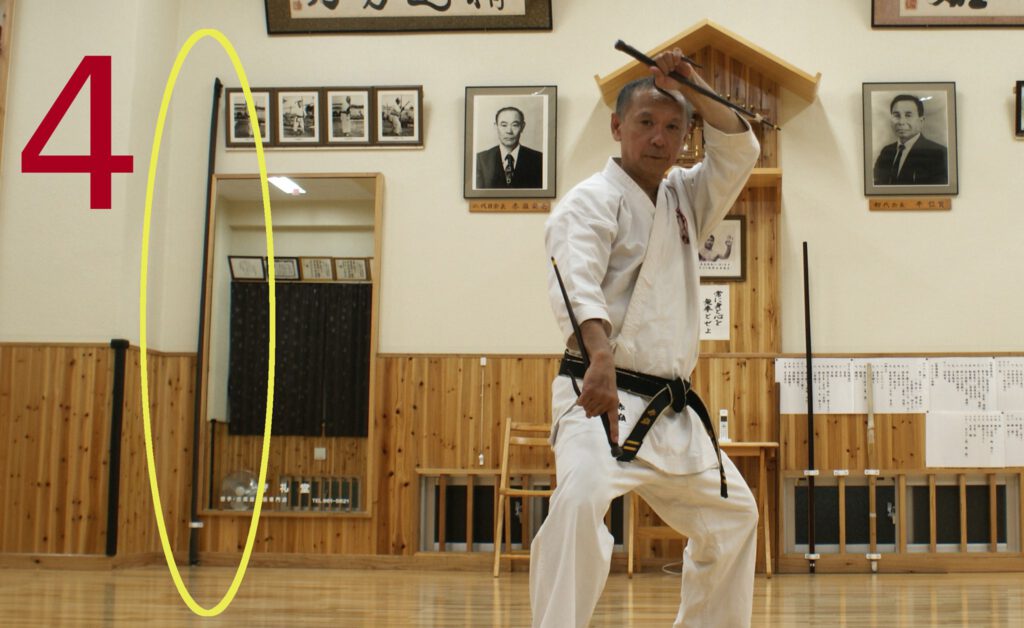In the bōjutsu tradition of Taira Shinken, we find a rarely seen pole weapon: the Kushaku-bō 九尺棒 (ca. 273 cm long staff). Early sources do not mention it but say that
“The Okinawan bō is either Rokushaku (ca. 182 cm) or Sanshaku (ca. 90 cm) long: the first represents the method of the short pike, the other is the method of the sword” (Okinawa Issen-nen Shi 1923: 333).
Only in 1964 Taira Shinken wrote the following (Taira 1964: 15):
“No clear indications are found in literature as regards the manner in which kobudō originated. Many of the kata bear the names of the masters who designed them. Originally, there were a considerable number of kata for every kind of kobudō – that is, for every single old weapon and the methods associated with them. However, due to poorly developed systems of practice, and because teachers forgot some kata towards the end of their lives, and also for other reasons, it can today no longer be clearly verified how many kata actually once existed. Therefore, the following supplement lists the kata that still exist today in Okinawa.”
Among the well-known kata provided in that list, we also find “Kushaku-bō”.
On an unnumbered leaf of Taira’s book we find a photo entitled “Various old weapons”, on the bottom of which the Kushaku-bō is found:

Finally, there is a description in chapter 4 (Taira 1964: 42), saying “The staff called Bō in Okinawa is called Gùn in Chinese [from which the Okinawa Kon derives]. The Kon can be roughly classified into three kinds: Sanshaku (about 90 cm), Rokushaku (about 182 cm), and Kushaku (about 273 cm).”
What more can be said about it?
In a posthumously published bequest of Taira is found a paper specifying the “Types of Practices in the Ryūkyū Kobudō Hozon Shinkōkai” (Taira 1997: 195-98). There, categorized under “Other weapons”, is found the following entry:
• Kushaku-bō (Tsuki-bō) (九尺棒(突キ棒)
In other words, an addition to the name has been made by adding “Tsuki-bō” (thrusting pole) to it. Therefore, the representative offensive technique of the Kushaku-bō appears to be thrusting. For a weapon of its length, this makes absolute sense. It may be compared to the European pike, the Japanese Yari or the Wing Tsun long-pole. Indeed, later it became generally accepted that “Kushaku-bō (Tsuki-bō)” belonged to the kata that derived their name from their most characteristic technical feature (see OKKBH 1994: 41; Nakamoto Masahiro and Tsuha Kiyoshi, in OKKJ 2008: 302).
Inoue Motokatsu – one of Taira’s leading disciples – also mentioned the Kushaku-bō, providing us with another contextual perspective (Inoue 1972: 1-2):
“When speaking of Ryūkyū Kobudō, it is generally noted that in the Kobujutsu of Okinawa training is carried out with both long and short weapons. If, by way of example, one speaks of the type of weapon one trains with, then the Kun, the Kushaku-bō, and the Sanshaku-bō belong to the long weapons.”

Nakamoto Masahiro also mentioned it in his list of “Kata of Bōjutsu Preserved in Today’s Okinawa” (Nakamoto 2007: 92), and there are more and more works that adopt it.
As shown above, the term “Kushaku-bō (Tsuki-bō)” appeared in various literary sources since Taira Shinken wrote about it in 1964.
The term also appears otherwise, such as in this kata list once written by Akamine Eisuke (–> see pic 3). Actually, in the new Shimbukan dōjō of Akamine Hiroshi sensei, a Kushaku-bō wrapped in a soft case leaned on the dōjō’s front side between at least 2010 and 2012 ( –> see pic 4, featuring Akamine sensei doing Sai kata). I never saw it being used, though and it is unclear to me whether it had actually been handed down intact or if it is a broken tradition (jitsuden 失伝).

I’d like to note that research about kinds of Okinawan bōjutsu appears to be a cumulative matter, with ever more kata and ever more weapons added to the syllabus during the recent century. As shown in the beginning of this short work, the Okinawa Issen-nen Shi (1923: 333) just spoke of two kinds of Okinawan bō, namely either Rokushaku (ca. 182 cm) or Sanshaku (ca. 90 cm). Forty years later, Taira Shinken roughly classified three kinds of bō as Kushaku, Rokushaku, and Sanshaku. A little less than fifty years later the general consensus had expanded again, saying that “the kinds of bō can be divided into the following lengths: ca. 91cm, ca. 1.21m, and ca. 1.82m. In addition, there are special lengths of ca. 2,42m and ca. 2,73m” (OKKJ 2008: 317).

And by this we get to one of the core issues of Okinawa kobudō: While the term kobudō in Japan is clearly defined and strictly reserved for old martial arts established prior to the Meiji Restoration (1868), in Okinawa, there is no such differentiation. Instead, the term “kobudō” in Okinawa is used for all kinds of weaponry, kata, and practices without any distinction being made as regards their tradition as being old kobudō (pre-1879), modern kobudō (1879-1945), new kobudō (post 1945, even though they incorporate older techniques), creative and fiction kobudō, festival and entertainment kobudō, “karate kata with kobudō weapons”, or even any ad-hoc performance made up on the spot. Like this, the arsenal of weapons and techniques in Okinawa kobudō grows and grows and grows, sometimes things are forgotten and instead new developments are added, and it is getting more and more difficult to differentiate between them and to categorize them according to a date of actual establishment and the actual source.
And just like in this case of the Kushaku-bō, every time we attempt to analyze a specific matter related to Okinawa kobudō, we sooner or later approach the core issue that the term “kobudō” for Okinawa has never been clearly defined.
© 2020, Andreas Quast. All rights reserved.
